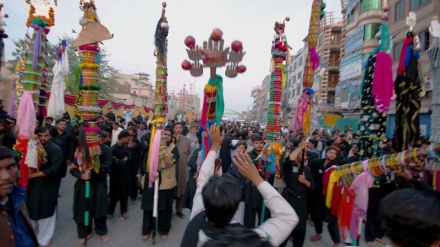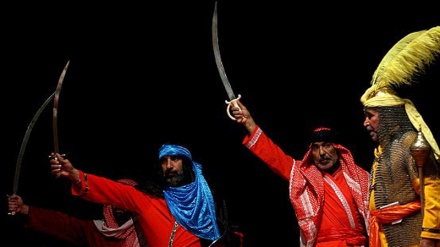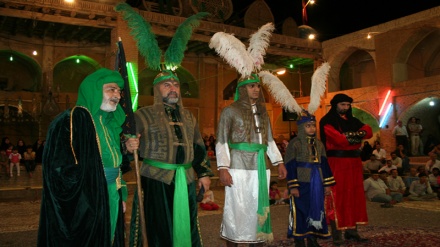Muharram mourning traditions in different lands - 15
In this series, which delves into the various mourning traditions associated with the Immortal Epic of Ashura in various lands, we look at the history of mourning for Imam Husain (AS).
We continue to discuss the impact of the Muharram mourning ceremonies of Iran on the Subcontinent, especially in the Shi’a Muslim communities.
As we said yesterday, the direct links between Safavid Iran and the Deccan or southern part of India saw the emergence of Shi’a Muslim dynasties, and their promotion of the culture of Ashura. It is also interesting to note that many Sunni Muslims in India are attached to the Prophet’s Ahl al-Bayt, and participate in the azadari, although they do not beat their chests. Nonetheless, they hold special discourses in the first ten days of Moharram in honour of the brave stand of Imam Husain (AS), and express grief over the tragedy that befell the Prophet's Household in Karbala.
As for the Shi'a Muslims of Haiderabad, they have some 125 Ashur-Khanahs, as the Hussainiyehs are called in the Deccan. The chief among them is Sar-Touq where a piece of the iron chain that was put by Yazid's forces around the neck of the survivor of the Karbala tragedy, Imam Zain al-Abedin (AS), is placed. Another major Ashur-Khanah is called Allaw-e Bibi, from where the famous Bibi ka Alam is taken out atop a caparisoned elephant on the day of Ashura. It is the principle procession, in which tens of thousands of black-clad chest-beating mourners take to the streets reciting elegies, while in front and behind them, march elephants, horses and camels, to signify the importance of the ceremony.
Ashura is a public holiday in India, and senior government officials also offer their condolences to the Shi'a Muslim community. In addition, special azadari gatherings are held in private places. One of the famous is the procession of the Alam of Hazrat Abbas (AS) held at Hussaini Kothi in the old city on the 8th of Moharram attended by thousands of devotees.
The city of Lucknow in north India, which in the first half of the 18th century saw the emergence of the Naishapuri Shi’a Muslim dynasty of Iranian orginin, after the invasion of Nader Shah Afshar, became the seat of power of Shi'a Muslim culture. During the Mughal period, and especially under Awrangzeb, Shi’a Muslims in northern India had no public rituals. But under the patronage of the Nawabs and their Shi’a Muslim courtiers and notables, such public rituals developed in Lucknow and rest of the realm that was called Awadh.
Many new believers in the Imams of Ahl al-Bayt entered the fold in this period, making their own contributions. Their rituals changed over time, shrines grew up, and lay believers of various classes practiced their faith in their own ways. Large numbers of Sunnis and Hindus were drawn into participation in the mourning rites for the martyrdom Imam Husain (AS), bringing their own influence to bear. The ruling family of Iranian origin, established several Hindu Hussainiyahs called ‘Imambaras’ in the local language. Nawab Asef od-Dowlah built the grand Hussainiyah to publicly mourn the martyrdom of Imam Husain (AS).
Similar structures were built in other places. Nawab Safdar Jang raised a building for this purpose in Delhi. During Shuja od-Dowlah's reign, Aqa Baqer Khan constructed an Imambarah in Lucknow. The north Indian Imambara was influenced by the Iranian Husayniyyah, or Takiyyah. Elegiac poetry that dominated the religious culture of the imambarahs gave public exposure to poets and reciters. Asef od-Dowlah's court attracted numerous poets and reciters of elegies, called marsiyyah-khwans, who came to hold an important place in public life. Mirza Muhammad Reza, was one of the greatest reciters of elegies in his day. Other Elegy reciters, such as Mulla Mohammad Shushtari and Shah Hussain Vilayat, came to Lucknow from Iran, and found appreciation at the Nawab's court.
The account of the martyrdom of Imam Husain (AS), and the ritual observances of mourning, proved central to the development of the Shi’a community in northern India, as the influences of Awadh spread to neighbouring provinces, cities, tow and villages. This central theme of the discourse of Muharram, or the "Karbala Paradigm" as t came to be called was based on existential truths about justice and injustice, life and death, faith and infidelity, etc.
The distinctive manner in which Awadh Shi’as, as well as Sunnis and Hindus, responded to the mourning month of Muharram merits investigation in its own right. But their response is all the more important in that it had implications for communal relations. One such is the ‘Kishnu Khalifa ka Imambara’ in Bashiratganj locality in the old city area. The Imambara, established in 1800, is famous for its Hindu ‘azadars’ or devotees who observe Muharram with all the religiosity of the Muslims.
In the Imambaras, two ritual props graced the room, a stairway-like pulpit or minbar, and a replica of the tomb or zarih of Imam Husain (AS). Two central rituals dominated Muharram: the Majlis or the mourning session, which was held in an imambarah or a private dwelling, and the procession. The procession, by far the more ancient of these rituals, originated at least by the time of the Iranian Buwaihid dynasty in early-tenth-century Iraq and Iran.
The stylized mourning session developed during the Safavid period in Iran, though gatherings to mourn the martyred Husain (AS) had more ancient antecedents. In Awadh in the early nineteenth century, notables held mourning sessions in the imambarahs twice a day during the first ten days of Muharram. The evening sessions, with their dazzling lighting derived from myriads of candles, mirrors, and chandeliers, were the best attended. The host hired a mawlavi to read that day's passage from a Persian prose text that described the sufferings of the Martyrs of Karbala and the struggle of the Prophet’s Ahl al-Bayt against the Omayyads.
MD/AS/SS


